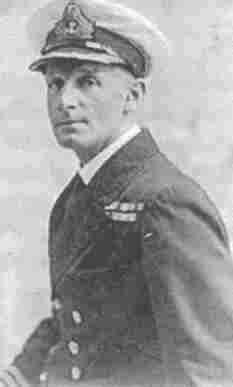- Author
- Graham-Smith, Mick
- Subjects
- Colonial navies, Biographies and personal histories, Ship histories and stories
- Tags
-
- RAN Ships
- None noted.
- Publication
- September 2009 edition of the Naval Historical Review (all rights reserved)
Henry Evelyn Charles Blagrove
The third family member was my uncle, Henry Evelyn Charles Blagrove. He was to be the first Royal Navy officer of flag rank to be killed in the Second World War. He had only just received his appointment as commander of the 2nd Battleship Squadron in the Home Fleet when he lost his life in the sinking of his flagship HMS Royal Oak by a German U-boat at Scapa Flow in the Orkneys.

Joining the naval service at the age of 14, he served as a midshipman in HMS Good Hope when he was 17 years old. In 1901 he departed the ship as a sub-lieutenant and over the next years earned promotion to full lieutenant aboard several ships including the Sapphire, Arab and Invincible. Further promotions led to service for the first time in a battleship, HMS Vengeance. The outbreak of the First World War found him aboard the newly commissioned HMS Tiger in the 1st Battle Cruiser Squadron, and he saw action at the Battle of Dogger Bank where he witnessed the sinking of the German battle cruiser Blucher.
Later in 1916 at the Battle of Jutland HMS Tiger incurred 15 hits, but he was unscathed. He then transferred to HMS Queen Elizabeth, flagship of the Home Fleet at Scapa Flow. It was here that he met his future wife Edith Lowe who was a Wren. Promoted to Lieutenant-Commander, he served out the war aboard Queen Elizabeth and witnessed the surrender of the German Grand Fleet and their subsequent scuttling at Scapa Flow.
In 1919, now as a commander, he became executive officer in the cruiser HMS Cardiff and was based in the Mediterranean until 1925. Further staff and training appointments followed before he was given command of HMS Curacao as captain and then flag captain in HMS Norfolk in 1932 and chief of staff to the Commander-in-Chief, America and West Indies Station. In 1937 he was appointed Naval ADC to the King. Promoted to Rear Admiral in 1939 as Admiral Superintendent of Chatham Dockyard, he was given the daunting task of rapidly preparing naval ships’ fighting capabilities for possible war with Germany. When war eventuated shortly afterwards, he was appointed as commander of the 2nd Battleship Squadron aboard Royal Oak.
Training and preparing his force, he sailed to the Orkney Islands, a move to cut off any possible breakout by German pocket battleships into the North Sea and Atlantic Ocean. The Royal Oak was an old battleship from the end of the First World War and much slower than her German counterparts. Winston Churchill described the Royal Sovereign class, of which the Royal Oak was one, as floating coffins. Royal Oak had undergone a rapid partial refit before the outbreak of war, but she was still subject to mechanical problems and could not put to sea, instead acting as antiaircraft protection for the anchorage. Admiral Blagrove, anticipating a possible air attack, sent her sister ship Royal Sovereign and the remainder of the Squadron out to sea.
The anchorage at Scapa Flow was the scene where the entire German Grand Fleet was scuttled in 1919, a poignant moment in time for the German naval establishment which they were not going to forget. The German Navy knew the location very well. Scapa was a flooded extinct volcano with access to the anchorage only possible between gaps in the rim perimeter. These had been obstructed by the Royal Navy with block ships and submarine boom nets.
On the night of 13 October 1939 when the war was just six weeks old, Royal Oak was struck by torpedoes from U-47 which had penetrated one of the four perimeter defences. Gunther Prien, the German submarine commander, had been able to negotiate a gap in the Kirk Sound on a fast incoming tide. Once inside Scapa Flow he found to his disappointment that there were only two ships at anchor, HMS Pegasus, a




